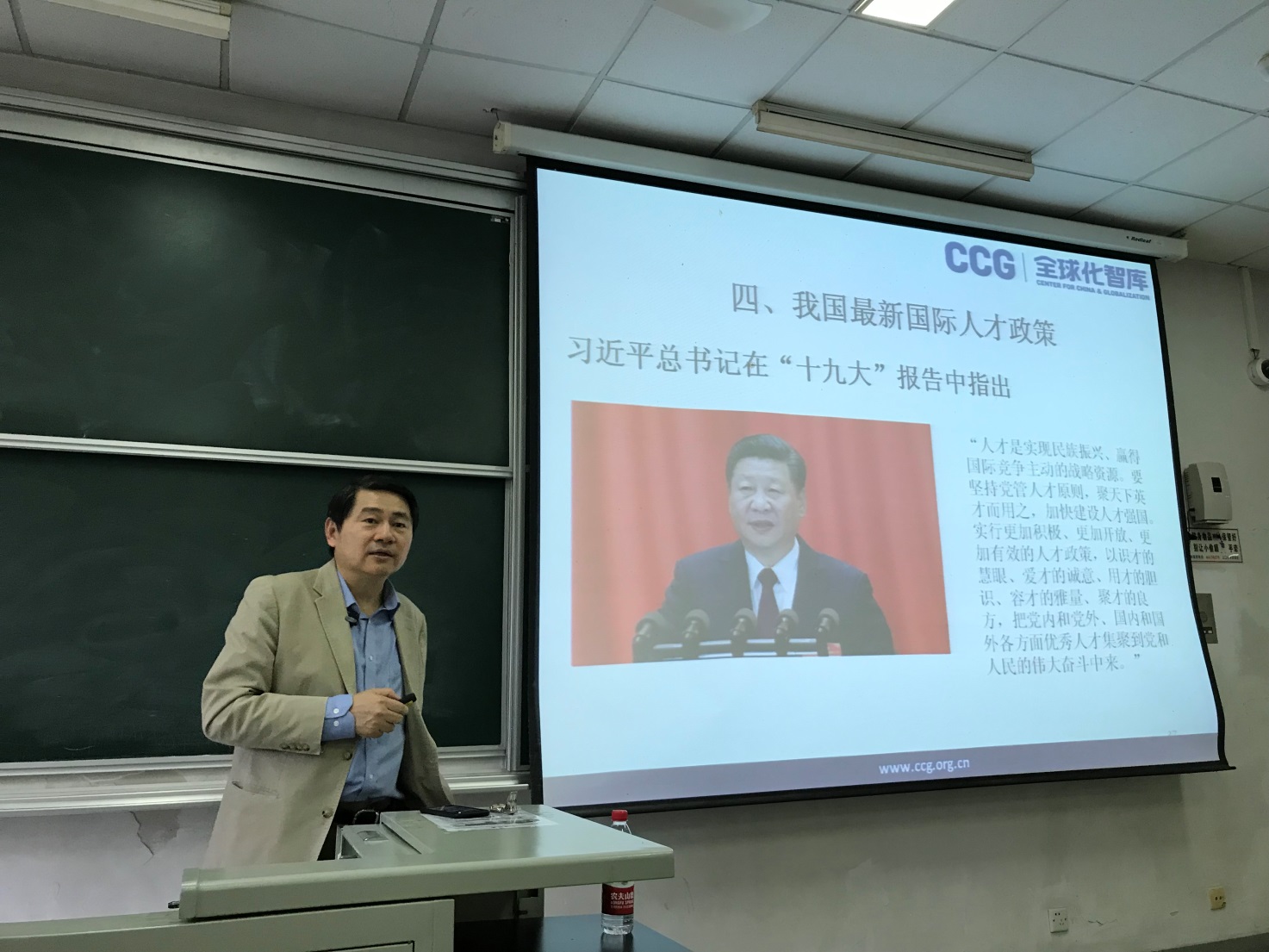
At the “High-End Social Science Lecture” held by Shanghai Academy on October 23, Professor Wang Huiyao, Chairman of the Center for China and Globalization (CCG) and Counselor of the State Council, delivered a speech themed Global Talent Trends and Shanghai’s Innovation in International Talent Policies, showing the research achievements of the CCG regarding international talents, introducing Shanghai’s current conditions in attracting international talents, and giving suggestions about Shanghai’s international talent strategies in the future.
Globalization has become a major trend of the time. During the 19th CPC National Congress, Xi Jinping, General Secretary of the CPC Central Committee, mentioned the concepts about globalization several times in the report, including economic globalization, the community of common destiny for all mankind, and the “Belt and Road” initiative. 2018 will see the 40th anniversary of China’s reform and opening-up, and China has ushered into an era of globalization in an all-round way.
Professor Wang Huiyao said, following the two waves of globalization respectively, about international trade, and international capital flows, global talent flows will be the trend in the future. “The competition is ultimately about talents. Whether China can become an innovation-oriented country and control the high-end part of globalization ultimately depends on talents.”
Professor Wang Huiyao said, China has a relatively late start in attracting international talents. The report jointly released by the CCG and the IOM shows that the proportion of foreign population to the permanent residents in China was 0.05%, far lower than the figure in Singapore (40%), Switzerland and Australia (30%), New Zealand and Canada (20%), as well as UK, France, Germany and Italy (10%). However, since the reform and opening-up, China has lost up to 10 million talents. The imbalance between the import and export of talents is unfavorable to China.
At the city level, take Beijing for example, more than 100,000 foreign residents account for about 0.5% of the permanent population with household registration in Beijing. That is a far cry from the nearly 40% ratio in such international metropolises like Los Angeles, Auckland, London and New York, and is consistent with its positioning as an international metropolis and a world city.
Furthermore, Professor Wang Huiyao also pointed out that the low proportion of foreign students in China is also one of the weaknesses of China in attracting international talents. China presently sees about 400,000 foreign students every year, and only 200,000 of them study for academic degrees, making up less than 1% of the total number of students in campuses, which is 35 million. Wang Huiyao attributed the result to three reasons, including the failure to adjust enrollment prices for years, internship and working restrictions on the foreign students in China, and the lack of English courses and international teachers in colleges. Besides, in most cases, foreign students are provided with courses separately, rather than studying together with Chinese students, and the varying teaching system also has certain influence on the said result.
According to the CCG’s report about the international competitiveness of talents by regions, Shanghai presently ranks the first among Chinese cities as shown in the comprehensive evaluation, that takes into account six aspects, i.e. the international talent size, international talent structure, international talent innovation index, international talent policies, international talent development and the life of international talents.
Professor Wang Huiyao said, Shanghai announced 30 more policies about talents in 2016 based on the 12 talent policies released in 2015. Shanghai has been a pioneer in attracting international talents in many ways, such as the marketization of green cards, i.e. a person with an annual salary of RMB600,000 or above can apply for a green card through his or her company. Prior to that, international talents are usually introduced through special programs like the Recruitment Program of Global Experts. Moreover, Shanghai became the first city in China to allow foreign students with master’s degrees to work in 2015, and further lowered the academic threshold to bachelor’s degree in the 30 talent policies newly released in 2016. Besides, Shanghai’s innovation measures also cover salary evaluation, third party evaluation, innovating in talent intermediary services, advancing the employment system reform in colleges and deepening the professional title reform, etc.
Although Shanghai ranks first in China with 65 points in the Report on China’s Regional International Talent Competitiveness 2017, it’s still at a low level globally when it comes to attracting international talents. So, Professor Wang Huiyao gave his suggestions about talent innovation in the future: First, Shanghai can further loosen restrictions on permanent residence for international talents, i.e. the restrictions on green card application; Second, Shanghai can take the lead to adopt the international practice and introduce green card preconditions; Third, Shanghai must beef up support for the foreign students working or studying in Shanghai, increase the proportion of foreign students in Shanghai’s universities to 10% or 20%, and try to run schools in cooperation with others; Fourth, before China establishes the immigration system, Shanghai can set up immigration departments related to social security and explore an immigration management system.
Professor Wang Huiyao said, “As a leader in attracting international talents, Shanghai must accelerate release of more open and friendlier policies. Just as Han Zheng said, Shanghai must not only be a highland for talents, but also be a peak of talents.”
(Article and photo by the Cooperation Division)